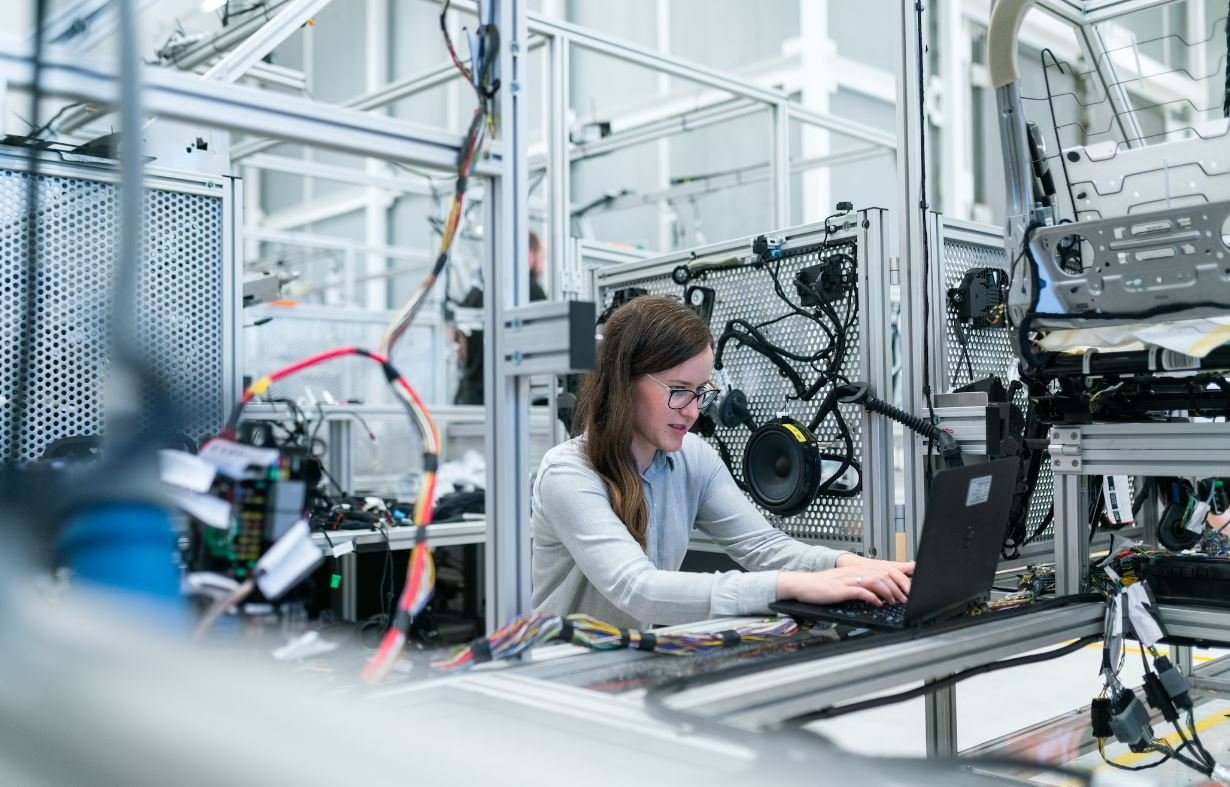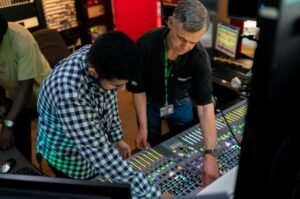Deep Learning ¿Qué es?
Deep Learning es una técnica dentro del campo de la inteligencia artificial que se basa en la construcción y entrenamiento de redes neuronales artificiales profundas.
Key Takeaways:
- Deep Learning es una técnica de inteligencia artificial que utiliza redes neuronales artificiales.
- Las redes neuronales profundas tienen múltiples capas ocultas que permiten la extracción de características y el aprendizaje automático.
- Esta técnica se utiliza en una variedad de aplicaciones, como reconocimiento de imágenes, procesamiento del lenguaje natural y conducción autónoma.
El aprendizaje profundo utiliza modelos de redes neuronales con múltiples capas ocultas para aprender y realizar tareas complejas. *Su objetivo principal es imitar el funcionamiento del cerebro humano, especialmente en términos de procesamiento de datos y reconocimiento de patrones. Se basa en la construcción de redes neuronales artificiales profundas, que pueden tener muchas capas y neuronas, permitiendo la extracción y representación de características más complejas en los datos de entrada.* Estas redes neuronales profundas pueden ser entrenadas para realizar diversas tareas, como reconocimiento de imágenes, procesamiento del lenguaje natural y conducción autónoma.
En el aprendizaje profundo, las redes neuronales artificiales profundas están compuestas por muchas capas que procesan y transforman los datos en múltiples etapas. Cada capa transforma los datos utilizando una función de activación para generar una salida que se utilizada por la siguiente capa. Esta estructura en capas permite que la red extraiga características cada vez más abstractas a medida que los datos se propagan a través de las capas. *La combinación de múltiples capas ocultas en estos modelos permite representar la complejidad de los datos y realizar tareas de aprendizaje automático, como la clasificación de imágenes o la generación de texto.*
Aplicaciones del aprendizaje profundo
El aprendizaje profundo tiene una amplia gama de aplicaciones en diferentes industrias. Algunos ejemplos de aplicaciones populares incluyen:
- Reconocimiento de imágenes y visión por computadora: El aprendizaje profundo ha logrado avances significativos en el reconocimiento de imágenes, permitiendo que los sistemas identifiquen y clasifiquen objetos en fotografías o videos.
- Procesamiento del lenguaje natural: Los modelos de aprendizaje profundo se utilizan en la traducción automática, la generación de texto y el análisis de sentimientos en el procesamiento del lenguaje natural.
- Conducción autónoma: El aprendizaje profundo se aplica en los sistemas de conducción autónoma para reconocer y comprender el entorno, así como para tomar decisiones de conducción en tiempo real.
| Empresa | Uso |
|---|---|
| Reconocimiento de voz y traducción automática | |
| Reconocimiento facial y recomendaciones de contenido |
El éxito del aprendizaje profundo se debe en parte a los avances en la disponibilidad de grandes cantidades de datos y a la capacidad de procesamiento cada vez mayor. Estos avances permiten entrenar y ajustar los modelos de aprendizaje profundo de manera más precisa, lo que ha llevado a mejoras significativas en el rendimiento.
| Año | Porcentaje de precisión en reconocimiento de imágenes |
|---|---|
| 2010 | 71% |
| 2019 | 90% |
El aprendizaje profundo sigue siendo un campo de investigación activo y en constante evolución, con nuevos avances y aplicaciones emergentes continuamente. Como resultado, el potencial de esta técnica para impulsar la inteligencia artificial y resolver problemas complejos es prometedor.
Conclusion
El aprendizaje profundo es una técnica de inteligencia artificial que utiliza redes neuronales artificiales profundas para realizar tareas complejas. Con aplicaciones en reconocimiento de imágenes, procesamiento del lenguaje natural y conducción autónoma, el aprendizaje profundo continúa evolucionando y promete impulsar el campo de la inteligencia artificial en el futuro.

Common Misconceptions
Deep Learning ¿Qué es?
Many people have misconceptions when it comes to understanding deep learning. It is important to address these misconceptions in order to gain a clearer understanding of what deep learning actually is.
- Deep learning is not the same as artificial intelligence.
- Deep learning is not just about neural networks.
- Deep learning does not require a large amount of labeled data to work effectively.
One common misconception is that deep learning is synonymous with artificial intelligence. While deep learning is a subfield of AI, it is important to recognize that AI encompasses a much broader range of technologies and techniques.
- Deep learning is just one approach within the field of AI.
- AI also includes other areas such as expert systems, natural language processing, and computer vision.
- Deep learning focuses specifically on training deep neural networks using large datasets.
Another misconception is that deep learning is solely about neural networks. While neural networks are a fundamental component of deep learning, it is not the only technique used.
- Deep learning can also involve other types of algorithms such as convolutional neural networks (CNNs) and recurrent neural networks (RNNs).
- These different types of neural networks are suited for different types of data and tasks.
- Deep learning also involves techniques such as transfer learning and reinforcement learning.
Some people believe that deep learning requires a massive amount of labeled data to be effective. While labeled data can certainly enhance the performance of deep learning models, it is not always a strict requirement.
- Deep learning can still learn useful representations from unlabeled data through techniques such as unsupervised learning.
- Transfer learning can also enable the use of smaller labeled datasets to achieve good results.
- The key is to leverage available data effectively and consider the specific problem and domain.

What is Deep Learning?
Deep learning is a subset of machine learning that has gained considerable attention in recent years. It involves training artificial neural networks with multiple layers to recognize patterns and make decisions without being explicitly programmed. Here are 10 interesting tables highlighting various aspects of deep learning.
Table of Applications
Deep learning has found applications in numerous fields, revolutionizing various industries. The following table showcases some exciting applications:
| Industry | Application |
|---|---|
| Healthcare | Medical image analysis |
| Finance | Fraud detection |
| Automotive | Autonomous driving |
| E-commerce | Product recommendations |
| Security | Facial recognition |
Table of Deep Learning Models
Deep learning models come in different flavors, each designed for specific tasks. The table below outlines some popular models and their uses:
| Model | Use |
|---|---|
| Convolutional Neural Network (CNN) | Image classification |
| Recurrent Neural Network (RNN) | Sequence prediction |
| Generative Adversarial Network (GAN) | Image generation |
| Transformer | Natural language processing |
| Deep Reinforcement Learning | Game playing |
Table of Deep Learning Frameworks
Deep learning frameworks provide the necessary tools and libraries to build and train neural networks efficiently. The following table lists some popular frameworks and their features:
| Framework | Features |
|---|---|
| TensorFlow | Large community support |
| PyTorch | Dynamic computation graphs |
| Keras | Simplified syntax |
| Caffe | Fast inference |
| Theano | Efficient GPU utilization |
Table of Deep Learning Advantages
Deep learning offers several advantages over traditional machine learning methods. Explore the table below to discover its benefits:
| Advantages | Explanation |
|---|---|
| Feature Extraction | Automatically learns relevant features from raw data |
| High Accuracy | Capable of achieving state-of-the-art results |
| Scalability | Performs well with large datasets and complex tasks |
| Real-time Processing | Capable of handling data in real-time |
| Adaptability | Can adapt and improve performance over time |
Table of Deep Learning Challenges
While deep learning brings tremendous possibilities, it also faces several challenges. Take a look at the table below for a glimpse of these obstacles:
| Challenges | Description |
|---|---|
| Data requirements | Demands large labeled datasets for effective training |
| Computational resources | Needs significant processing power and memory |
| Interpretability | Difficulty in understanding the decision-making process |
| Overfitting | Can become overly specialized to the training data |
| Robustness | Vulnerability to adversarial attacks and noisy input |
Table of Deep Learning Libraries
There exist various libraries that simplify the usage of deep learning techniques. Explore the following table for some notable examples:
| Library | Language |
|---|---|
| TensorFlow | Python |
| PyTorch | Python |
| Caffe | C++ |
| Deeplearning4j | Java |
| MXNet | Multiple languages |
Table of Deep Learning Breakthroughs
Deep learning has achieved remarkable breakthroughs in various domains. The table below highlights some of these notable achievements:
| Domain | Breakthrough |
|---|---|
| Computer Vision | Image recognition at human accuracy levels |
| Natural Language Processing | Machine-generated text indistinguishable from human-written |
| Healthcare | Improved diagnostics with medical image analysis |
| Robotics | Enhanced perception and control in robotic systems |
| Social Media | Efficient content filtering and personalized recommendations |
Table of Deep Learning Resources
Deep learning resources are abundant, aiding enthusiasts in their learning journey. Check out the table below for some valuable resources:
| Resource | Description |
|---|---|
| Research Papers | Online repositories of academic and industry publications |
| Online Courses | Interactive learning platforms offering deep learning courses |
| Open-source Projects | GitHub repositories containing deep learning code and models |
| Community Forums | Online platforms for discussions and knowledge sharing |
| Regular Podcasts | Audio shows featuring deep learning discussions and interviews |
In conclusion, deep learning has become a game-changer, transforming industries and enabling breakthroughs previously thought impossible. With its wide range of applications, powerful models, and supporting frameworks and libraries, deep learning continues to push the boundaries of what is achievable. However, challenges, such as data requirements and interpretability, need to be addressed to unlock its full potential. As the field progresses, accessing deep learning resources becomes increasingly important for aspiring experts and researchers.
Frequently Asked Questions
What is deep learning?
Deep learning is a subset of machine learning that utilizes artificial neural networks mimicking the human brain to analyze and process large amounts of data, learn from it, and make accurate predictions or decisions without being explicitly programmed.
What are artificial neural networks?
Artificial neural networks are computational models inspired by the structure and function of biological neural networks. They consist of interconnected nodes, or artificial neurons, that process and transmit information. These networks are used in deep learning to learn patterns and relationships within data.
How does deep learning work?
Deep learning involves training a deep neural network by exposing it to vast amounts of labeled or unlabelled data. The network uses its multiple layers to extract progressively higher-level features from the input data. Through an iterative process known as backpropagation, the network adjusts the weights of its connections to minimize the error and improve its accuracy over time.
What are the applications of deep learning?
Deep learning has found applications in various fields, including computer vision, natural language processing, speech recognition, recommendation systems, and healthcare. It can be used for image and object recognition, language translation, voice assistants, automatic driving, and medical diagnostics, among other things.
How is deep learning different from machine learning?
While both deep learning and machine learning are subsets of artificial intelligence, deep learning focuses on a specific technique that involves training deep neural networks with multiple layers, whereas machine learning encompasses a broader range of algorithms for data analysis and pattern recognition.
What are the advantages of deep learning?
Deep learning algorithms have the ability to automatically learn and extract features from raw data, eliminating the need for manual feature engineering. They can handle large and complex datasets, and are capable of achieving state-of-the-art performance in various tasks with minimal human intervention.
What are the limitations of deep learning?
Deep learning models often require a large amount of labeled training data to generalize well. They can be computationally expensive to train, especially for complex networks. Deep learning models also lack interpretability, making it difficult to understand how they arrive at their decisions.
What are some popular deep learning frameworks?
There are several popular deep learning frameworks, including TensorFlow, PyTorch, Keras, and Caffe. These frameworks provide high-level APIs that simplify the process of building, training, and deploying deep learning models, and also offer extensive community support and pre-trained models.
Is deep learning the same as artificial intelligence?
No, deep learning is a subfield of artificial intelligence. Artificial intelligence encompasses a broader range of techniques and approaches aimed at creating intelligent systems that can exhibit human-like behavior, whereas deep learning specifically focuses on training deep neural networks to learn and make predictions.
How can I get started with deep learning?
To get started with deep learning, you can begin by learning the basics of machine learning and familiarizing yourself with common deep learning frameworks. There are numerous online courses, tutorials, and resources available that can help you gain knowledge and hands-on experience in deep learning.




